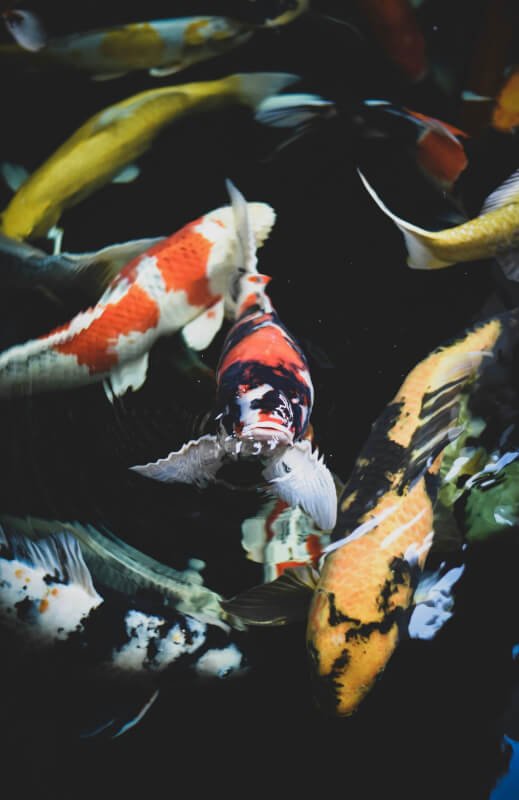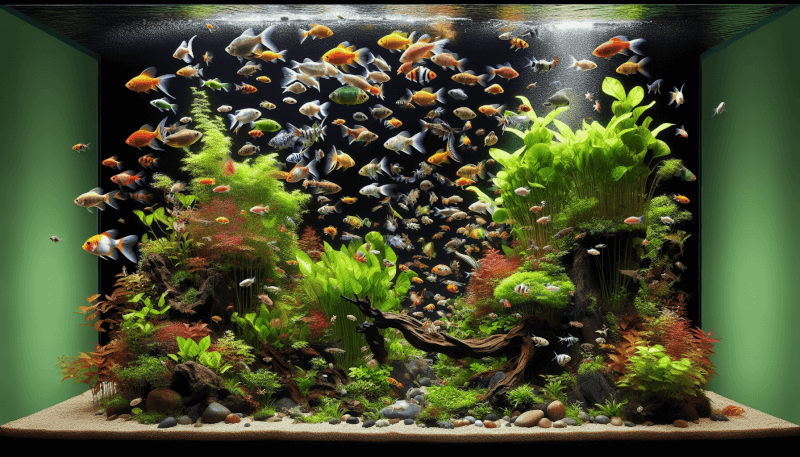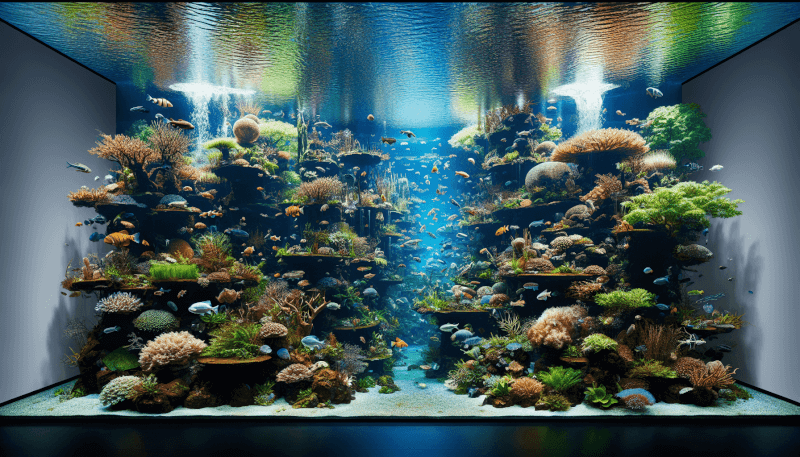In the world of aquarium aesthetics, achieving a harmonious balance between fish and plants is the key to creating a captivating underwater paradise. By carefully selecting the right combination of aquatic life and plant species, you can create a visually stunning and thriving ecosystem that not only pleases the eye but also provides a healthy habitat for your beloved fish. Dive in as we explore the art of creating this delicate balance, where nature and design come together in perfect harmony. So, get ready to transform your aquarium into a vibrant and captivating aquatic masterpiece – one that is sure to bring you joy and tranquility for years to come.

Fish Compatibility
Researching compatible fish species
When setting up an aquarium, it is crucial to research and consider the compatibility of the fish species you wish to keep. Not all fish get along well with each other, and choosing incompatible species can lead to aggression, stress, and even fatalities. Take the time to learn about the temperament, behavior, and social needs of different fish species to ensure a harmonious and peaceful tank environment for all inhabitants.
Considering fish behavior and size
Understanding the behavior and size of fish is essential when selecting compatible species. Aggressive fish may prey on smaller or more timid species, disrupting the tranquility of the tank. Additionally, some fish have specific habitat requirements, such as bottom-dwelling or territorial habits, which need to be taken into account when planning your aquarium. Keep in mind that larger fish may require more space, so it is crucial to consider the ultimate size of your fish when determining appropriate tank size.
Choosing fish that coexist well with plants
To create a harmonious ecosystem, it is important to choose fish species that coexist well with aquatic plants. Some fish naturally graze on plants, damaging their leaves and uprooting them, which can be detrimental to the overall aesthetic and health of your aquarium. Opt for fish species that have a minimal impact on plants, such as small schooling fish or herbivorous species that primarily feed on algae. By selecting fish that respect plant life, you can create an environment where both fish and plants can thrive.
Plant Selection
Understanding plant requirements
To create a successful planted aquarium, it is essential to understand the specific requirements of the plants you wish to include. Different species of plants have varying needs in terms of lighting, substrate, and nutrient levels. Some plants require high-intensity lighting, while others thrive in dimmer conditions. Similarly, certain plants may require nutrient-rich substrates, while others can survive with minimal supplementation. Researching the specific requirements of your chosen plant species will help you provide the optimal conditions for their growth and development.
Choosing plants compatible with fish species
Just as it is important to choose fish species that are plant-friendly, it is equally crucial to select plants that are compatible with your chosen fish species. Some fish have a tendency to nibble on or uproot plants, which can be frustrating and detrimental to the overall aesthetics of your aquarium. Opt for hardy plant species that can withstand occasional nibbling or choose plants that can be securely anchored to prevent any fish-induced upheaval. By selecting plant species that can coexist peacefully with your fish, you can ensure that both aspects of your aquarium thrive together.
Considering plant size and growth rate
When selecting plants, it is important to consider their size and growth rate. Some plants may grow rapidly and may require regular trimming or maintenance to prevent overcrowding in the aquarium. On the other hand, slow-growing plants may take longer to establish, but they are often more low-maintenance. Additionally, consider the ultimate size of the plants, as larger specimens may overshadow smaller ones, leading to an uneven and unbalanced visual appeal. By carefully selecting a variety of plant sizes and growth rates, you can create a visually appealing and well-balanced aquarium landscape.
Aquarium Size and Layout
Determining appropriate aquarium size
The size of your aquarium plays a crucial role in the overall health and well-being of your fish and plants. When choosing an aquarium, consider the adult size of your chosen fish species and provide them with enough space to swim comfortably. Overcrowding can lead to stress, poor water quality, and increased aggression among fish. Additionally, keep in mind that plants also require space to grow and spread their roots. A larger aquarium offers more stability and easier maintenance, so if you have the space, opting for a larger tank is usually a favorable choice.
Designing a layout that allows for fish and plant growth
When designing the layout of your aquarium, it is important to consider the growth patterns and space requirements of both fish and plants. Plan out the placement of your plants, leaving enough space for them to grow, spread, and receive adequate light. Additionally, create open areas for swimming and provide hiding spots for shy or territorial fish. By carefully arranging the elements in your tank, you can create a visually pleasing environment that caters to the needs of both your fish and plants.
Creating zones for different plant species
To add visual interest and enhance the overall aesthetic appeal of your aquarium, consider creating distinct zones for different plant species. Arrange plants of varying heights, colors, and textures to create a dynamic and visually appealing display. For example, you can create a foreground zone with low-growing plants, a midground zone with taller and more colorful plants, and a background zone with larger, bushier specimens. This layered approach not only adds depth but also allows you to cater to the specific needs of different plants in terms of lighting and growth conditions.
Water Quality and Parameters
Maintaining proper water temperature
Maintaining the proper water temperature is crucial for the health and well-being of both fish and plants in your aquarium. Different species of fish and plants have specific temperature requirements, so it is important to research and select species that share similar temperature preferences. Use a reliable aquarium heater and thermometer to ensure that the water temperature remains within the optimal range for your chosen inhabitants. Sudden and drastic temperature fluctuations can cause stress and even lead to illness or death, so be vigilant in monitoring and maintaining the water temperature.
Monitoring and controlling pH levels
The pH level of the water in your aquarium can greatly impact the health and well-being of your fish and plants. Different fish have different pH preferences, so it is crucial to choose species that can thrive within a similar range. Similarly, certain plant species thrive in specific pH conditions. Regularly test the water pH and make necessary adjustments to ensure that it remains within the optimal range for both your fish and plants. A stable pH level is essential for the overall health, growth, and vibrant coloration of your aquarium inhabitants.
Providing appropriate lighting for plants
Lighting is an essential component for the growth and photosynthesis of aquatic plants. Different plant species have varying lighting requirements, ranging from low to high intensity. Research the specific lighting needs of your chosen plant species and select appropriate aquarium lighting fixtures to meet those requirements. Additionally, consider using timers or dimmers to provide consistent and controlled lighting throughout the day. Adequate lighting not only promotes healthy plant growth but also enhances the overall aesthetic appeal of your aquarium.

Nutrient Balance
Providing adequate nutrients for plant growth
To ensure lush and vibrant plant growth, it is important to provide adequate nutrients in your aquarium. Nutrients such as nitrogen, phosphorus, and potassium are essential for plants to thrive. Consider using a nutrient-rich substrate or supplementing the water column with liquid fertilizers to provide essential nutrients for plant growth. Regularly test the water parameters and adjust nutrient levels as necessary to promote healthy plant growth. Providing proper nutrition to your plants will result in a flourishing ecosystem and a visually stunning aquarium.
Avoiding excessive nutrient levels that may harm fish
While providing adequate nutrients for plant growth is essential, it is equally important to avoid excessive nutrient levels that can harm fish. Excessive nutrient concentrations, particularly in the form of nitrates and phosphates, can contribute to poor water quality and the growth of unsightly algae. Regular water testing and diligent maintenance are necessary to prevent nutrient buildup and its detrimental effects on fish health. Balancing nutrient levels is a delicate and ongoing process, but it is crucial for maintaining a healthy and balanced aquarium ecosystem.
Using fertilizers and supplements
In addition to providing nutrients through substrates and water column supplements, you can use specialized fertilizers and supplements to enhance plant growth and development. These products typically contain a blend of macronutrients and micronutrients specifically formulated for aquatic plants. When using fertilizers and supplements, follow the instructions carefully to avoid overfeeding your plants and causing nutrient imbalances. A balanced approach to nutrient supplementation will ensure that your plants receive the necessary elements for their growth and well-being.
Filtration and Circulation
Choosing an appropriate filtration system
Proper filtration is essential for maintaining water quality and clarity in your aquarium. The filtration system helps remove debris, excess nutrients, and pollutants, ensuring a healthy environment for both fish and plants. Choose a filtration system that is suitable for the size of your aquarium and provides efficient mechanical, chemical, and biological filtration. Regular cleaning and maintenance of the filter media are necessary to keep the filtration system running optimally. A well-designed and properly maintained filtration system will contribute to the overall health and success of your aquarium.
Ensuring proper water circulation
In addition to filtration, adequate water circulation is important for maintaining a healthy and well-oxygenated aquarium. Proper water movement helps distribute heat, nutrients, and oxygen throughout the tank, ensuring that fish and plants thrive. Place your filtration outlets strategically to create gentle but sufficient water movement throughout the entire aquarium. Avoid dead spots where water becomes stagnant, as they can lead to the accumulation of debris and the growth of harmful bacteria. By promoting proper water circulation, you contribute to the overall well-being and vitality of your aquarium inhabitants.
Maintaining water quality and clarity
Regularly monitoring and maintaining water quality and clarity is crucial for the long-term success of your aquarium. Test the water parameters regularly, including ammonia, nitrite, and nitrate levels, as well as pH and hardness. Conduct regular water changes to remove accumulated waste, excess nutrients, and other contaminants. Keep in mind that both fish and plants can impact water quality, so it is important to find a balance between their needs. Clear and healthy water is not only visually appealing but also a sign of a well-maintained and thriving aquarium ecosystem.

Feeding and Waste Management
Feeding fish a balanced diet
Providing your fish with a balanced and appropriate diet is essential for their health and well-being. Different fish species have different nutritional requirements, so research their dietary needs and choose high-quality fish food that meets those requirements. Overfeeding can lead to excess waste and poor water quality, so feed your fish only what they can consume within a few minutes. Consider supplementing their diet with occasional treats, such as frozen or live foods, to provide additional variety and nutrition. A balanced diet will support the overall health and vitality of your fish.
Preventing overfeeding and excess waste
Overfeeding is a common issue in aquariums and can lead to nutrient imbalances, poor water quality, and increased algae growth. It is important to feed your fish only what they can consume within a few minutes. Uneaten food should be promptly removed from the tank to prevent its decomposition and the release of excess waste. By avoiding overfeeding, you can maintain a cleaner and healthier aquarium environment for both your fish and plants.
Managing fish waste as a fertilizer for plants
Fish waste, in the form of excreted nitrogen compounds, can serve as a valuable source of nutrients for your aquatic plants. Nitrogen is an essential element for plant growth, and converting fish waste into a usable form is an eco-friendly and cost-effective way to provide nutrients for your plants. Utilize a well-maintained filtration system that includes biological filtration to convert fish waste into nitrates, which can be readily absorbed by plants. Creating a closed-loop system where fish waste is recycled as plant fertilizer not only benefits your plants but also contributes to the overall sustainability of your aquarium.
Regular Maintenance
Performing regular water changes
Regular water changes are vital for maintaining a healthy and balanced aquarium ecosystem. They help remove accumulated waste, excess nutrients, and harmful substances, refreshing the water and promoting optimal conditions for fish and plants. The frequency and volume of water changes depend on the size of your aquarium, the number of inhabitants, and the overall water quality. As a general guideline, aim to change 10-20% of the water every 1-2 weeks. When performing water changes, use a dechlorinator to remove chlorine and chloramine, ensuring that the replacement water is safe for your aquarium inhabitants.
Pruning and trimming plants as needed
Aquatic plants require regular maintenance to thrive and maintain an attractive appearance. Prune and trim plants as necessary to remove dead or decaying leaves, promote new growth, and maintain the desired shape and size. Use a clean pair of aquarium scissors or pruning tools to avoid introducing any potential contaminants into your tank. Regular pruning not only improves the overall aesthetics of your aquarium but also helps prevent the buildup of debris that can contribute to poor water quality.
Monitoring and adjusting nutrient levels
Regularly monitor the nutrient levels in your aquarium to ensure that they remain within the appropriate range for both fish and plants. Conduct routine water tests to measure nitrate, phosphate, and other nutrient concentrations. Use these test results to make necessary adjustments to your feeding, fertilization, and maintenance routines. Strive for a balanced nutrient profile that fosters healthy plant growth without causing harm to your fish. By monitoring and adjusting nutrient levels, you can maintain a stable and thriving aquarium environment.

Preventing and Managing Algae
Controlling nutrient levels to prevent algae blooms
Algae growth is a common challenge in aquariums, and it can be unsightly and detrimental to the health of your fish and plants. One effective way to prevent algae blooms is by controlling nutrient levels in your aquarium. Excessive nutrients, particularly nitrates and phosphates, can fuel algae growth. Regularly test the water and take measures to reduce nutrient concentrations if they are too high. This can include adjusting feeding amounts, enhancing filtration, and implementing water changes. By maintaining proper nutrient levels, you can minimize the risk of algae issues and promote a clean and attractive aquarium.
Using algae-eating species as natural control
Introducing algae-eating species can be an effective and natural way to control algae growth in your aquarium. Many fish, such as certain species of plecos, Siamese algae eaters, and certain species of snails and shrimp, have a natural appetite for algae. Introducing these species into your tank can help keep algae growth in check and maintain water quality. However, it is important to research the species thoroughly and ensure they are compatible with your existing fish and plants. Additionally, provide supplemental sources of food for these algae-eating species to ensure their long-term health and well-being.
Implementing algae control methods
In addition to maintaining optimal nutrient levels and utilizing algae-eating species, there are various methods you can implement to control algae growth in your aquarium. These may include manual removal of algae with brushes or scrapers, reducing the duration of lighting periods, using algae inhibitors or treatments, and implementing a proper water maintenance routine. It is important not to rely on a single method but rather combine different strategies to effectively control and manage algae growth. Regular monitoring and maintenance will help keep algae issues at bay and ensure a visually appealing and healthy aquarium.
Seeking Expert Advice
Consulting with aquarium professionals or hobbyists
If you encounter challenges or have specific questions regarding your aquarium setup, consider consulting with aquarium professionals or experienced hobbyists. These individuals have firsthand experience and can provide valuable advice and guidance based on their expertise. They can help troubleshoot issues, suggest appropriate solutions, and offer valuable insights into achieving a harmonious balance between fish and plants. Whether you visit a local aquarium store or seek advice from online forums, reaching out to knowledgeable individuals can greatly enhance your aquarium journey.
Joining online forums and communities
Another excellent source of advice and support is online aquarium forums and communities. Joining these platforms allows you to connect with a diverse group of aquarium enthusiasts who are eager to share their experiences, insights, and tips. Participate in discussions, ask questions, and learn from the collective knowledge and expertise of fellow hobbyists. Online communities provide a platform for continuous learning, problem-solving, and inspiration, helping you stay informed and connected within the aquarium hobby.
Attending workshops or seminars
Attending workshops or seminars related to aquarium keeping is a fantastic way to expand your knowledge and skills. These educational events often cover a wide range of topics, including fish and plant selection, water chemistry, maintenance techniques, and advanced aquascaping. Through workshops and seminars, you can engage with industry professionals and experts, ask questions, and gain hands-on experience. These events provide an invaluable opportunity to learn from experienced individuals and stay up to date with the latest trends and advancements in the world of aquarium aesthetics.
In conclusion, achieving a harmonious balance between fish and plants in your aquarium requires careful consideration of fish compatibility, plant selection, aquarium size and layout, water quality and parameters, nutrient balance, filtration and circulation, feeding and waste management, regular maintenance, algae prevention and management, as well as seeking expert advice. By following these guidelines and investing time and effort into creating an optimal environment for both fish and plants, you can enjoy a visually stunning, vibrant, and thriving aquarium that showcases the beauty of aquatic life. Happy aquarium keeping!

